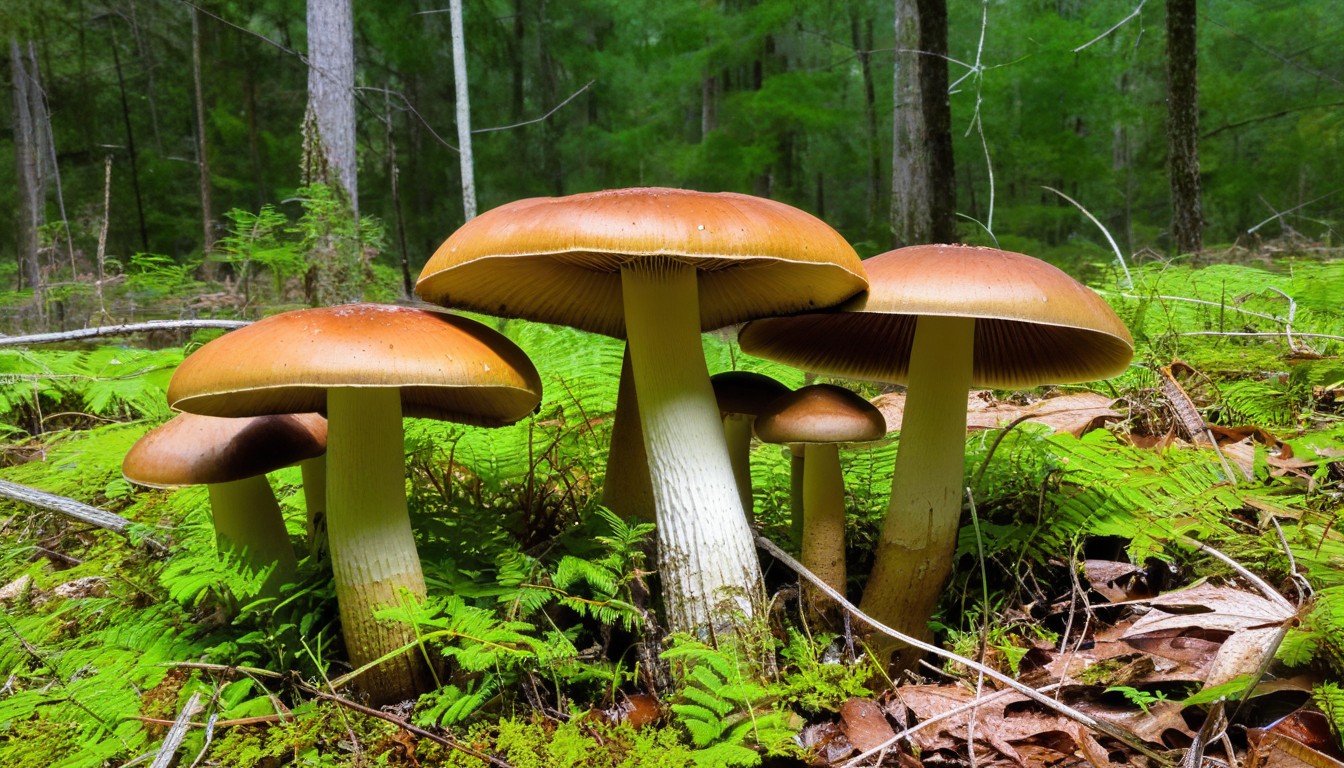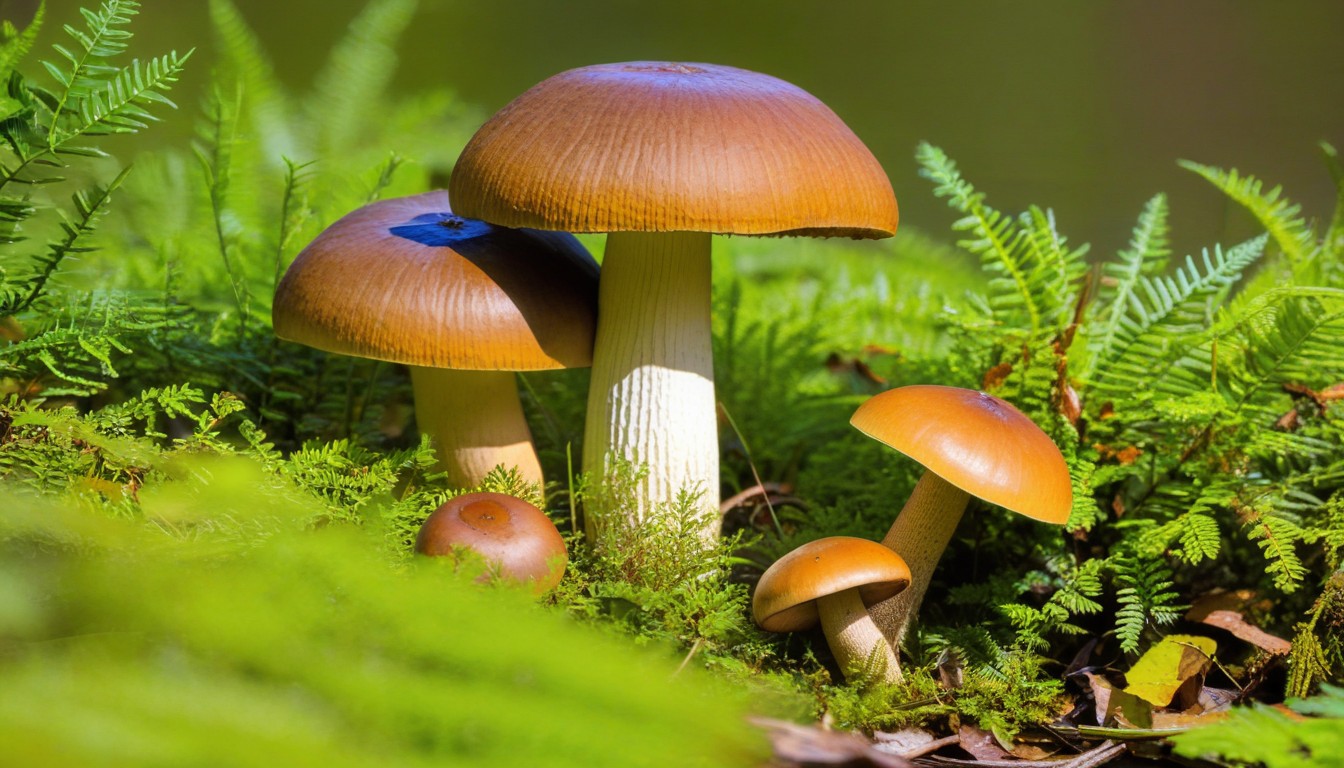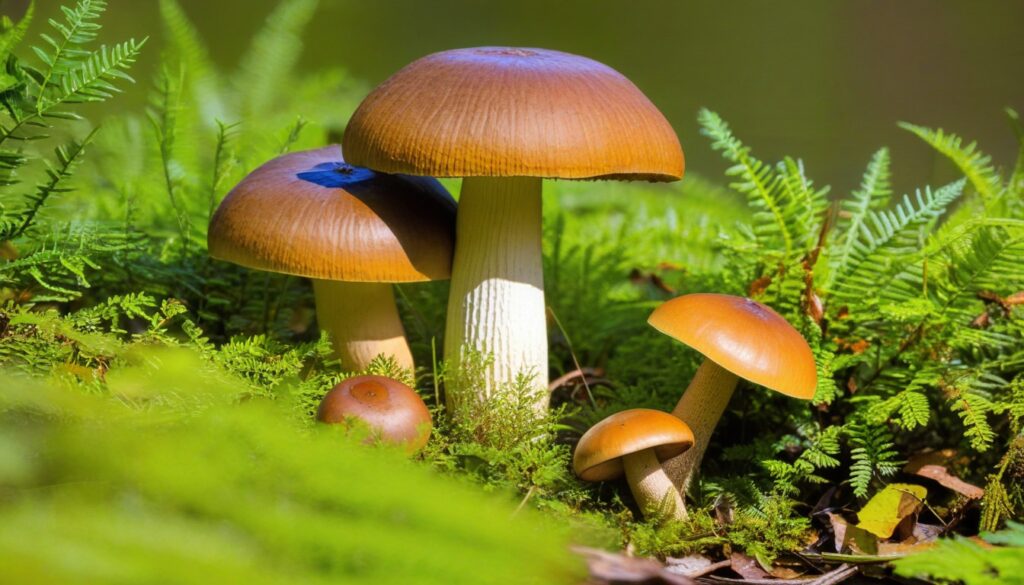Welcome to our comprehensive guide to Florida Bolete Mushrooms! Whether you’re a seasoned foraging expert or a newbie to the hobby, this guide will help you identify and savor the diverse range of Bolete Mushrooms found in Florida’s lush forests and woodlands.
From their unique characteristics to their environmental significance, we’ll explore everything you need to know about Florida Bolete Mushrooms. We’ve compiled a wealth of information to help you confidently identify these fascinating fungi and safely forage them. We’ll even share some recipes and highlight their potential health benefits!
Key Takeaways
- Learning to identify and forage Florida Bolete Mushrooms can be a fun and rewarding experience.
- It’s crucial to be well-informed about safe foraging practices and to avoid harvesting potentially toxic look-alikes.
- Florida Bolete Mushrooms are highly valued in culinary circles for their meaty texture and complex flavors.
- They are also associated with potential medicinal and health benefits.
- Conservation efforts are vital to maintain the delicate balance of Florida’s ecosystems and support healthy Bolete Mushroom populations.
Introduction to Florida Bolete Mushrooms
Welcome to the world of Florida Bolete Mushrooms! These fascinating fungi are found in forests throughout the state and are highly valued for their unique flavor and nutritional properties. With their distinctive caps, stalks, and pores, Bolete Mushrooms are easily recognizable and play an important role in the local ecosystem as decomposers and mycorrhizal associates with trees. In this guide, we will explore the characteristics, identification, foraging, culinary uses, and potential health benefits of Florida Bolete Mushrooms, as well as their conservation and environmental impact. Let’s get started!
Varieties of Florida Bolete Mushrooms
Florida Bolete Mushrooms provide a diverse range of varieties, each with unique features and characteristics. Whether you’re a novice forager or an experienced mycophile, exploring the different types of Florida Bolete Mushrooms can be an exciting adventure.
|
Variety |
Features |
Location |
|---|---|---|
|
Suillus Pictus |
Yellow to reddish-brown cap, with brown pores changing to olive-brown. |
Can be found under pine trees, especially during the summer and fall months. |
|
Boletellus Ananas |
Yellow to orange-brown cap, with a surface resembling scaly turkey skin. |
Usually found under hardwood trees, such as oak and beech trees, in summer and fall. |
|
Rubroboletus Pulchrotinctus |
Reddish-pink to purple cap, with a stipe covered in velvety red scales. |
Commonly found under pine trees, from late summer to late fall. |
|
Tylopilus Ballouii |
Cap ranges from reddish-brown to chestnut-brown, with a velvety surface covering. |
Usually found under hardwood trees, such as oak and hickory, from summer to fall. |
Make sure to consult reputable field guides or a knowledgeable forager before consuming any unfamiliar Florida Bolete Mushrooms, as some toxic lookalikes may exist. Happy foraging!
Habitat and Growing Conditions

Florida Bolete Mushrooms can be found growing in a variety of habitats, including forests, woodlands, and even in some urban environments. These mushrooms typically grow in association with certain species of trees, including oak, pine, and hickory trees. The ideal growing conditions for Florida Bolete Mushrooms include warm temperatures, moderate humidity, and well-drained soil.
The fruiting season for Florida Bolete Mushrooms typically occurs between May and October, with peak growth in the late summer months. During this time, it is important to be mindful of the environmental factors that can impact mushroom growth, such as drought or heavy rainfall. Excessive moisture can lead to an increase in fungal diseases, which can impact both the growth and quality of Florida Bolete Mushrooms.
To maximize your chances of finding Florida Bolete Mushrooms, it is recommended to forage in areas with a history of mushroom growth and to be mindful of the signs of their preferred growing conditions. These signs may include areas with decomposing organic matter or other types of fungal growth.
Ideal Growing Conditions for Florida Bolete Mushrooms
|
Environmental Factor |
Ideal Range |
|---|---|
|
Temperature |
70-85 °F |
|
Humidity |
50-70% |
|
Soil |
Well-drained |
|
Growing Season |
May-October |
By understanding the preferred habitat and growing conditions of Florida Bolete Mushrooms, you can greatly increase your chances of a successful foraging excursion.
Foraging Florida Bolete Mushrooms
Foraging Florida Bolete Mushrooms can be a rewarding and enjoyable experience when approached safely and responsibly. To ensure a successful harvest, it is crucial to utilize the proper tools and techniques while respecting the environment and the local community.
Essential Tools
- A sharp knife for cutting the stem close to the ground
- A soft-bristled brush for removing any dirt or debris
- A basket or mesh bag to store your mushrooms
- A field guide or mobile app for verifying identification
Best Practices
It is essential to follow these best practices to ensure a sustainable harvest:
- Only harvest mushrooms that are fully mature and free from any damage or decay.
- Take care not to disturb the surrounding vegetation or ecosystem.
- Use caution when handling the mushrooms as some species can be toxic or cause skin irritation.
- Never remove more than one-third of the mushrooms from a single location.
- Do not trespass on private property or violate any local regulations.
Ethical Considerations

Respect for the environment and the community is crucial when foraging Florida Bolete Mushrooms. Follow these ethical considerations to minimize your impact:
- Only forage in designated areas or with the permission of the landowner.
- Do not damage or disturb the surrounding vegetation or wildlife.
- Dispose of any waste or debris properly, leaving the foraging area cleaner than you found it.
- Consider sharing your knowledge and experience with others or joining a local mycology group to deepen your understanding of this fascinating subject.
Identifying Florida Bolete Mushrooms
When it comes to identifying Florida Bolete Mushrooms, there are a few key characteristics you should look out for to ensure their safe consumption.
The first step is to check the cap of the mushroom. Florida Bolete Mushrooms typically have a large, smooth cap with a dome shape. The cap can range in color from brown to reddish-brown, and in some cases, yellow. The cap of the mushroom should also be moist and not dry or cracked.
Next, examine the stem of the mushroom. The stem is usually thick and bulbous with a texture similar to that of a sponge. The stem color can vary from white to brown, and in some cases, reddish-brown.
Another important feature to consider is the presence of pores underneath the cap of the mushroom. Florida Bolete Mushrooms have small, round, yellowish-brown pores that darken with age.
It’s essential to note that while Florida Bolete Mushrooms are generally safe to eat, there are a few toxic look-alikes to be aware of. One such look-alike is the Poisonous bittersweet bolete, which has red and yellow coloration under the cap and a blue-green stain on the stem when cut.
Before consuming any wild mushroom, it’s crucial to be confident in your identification skills or consult a trained mycologist for confirmation.
By familiarizing yourself with these key characteristics and distinguishing factors, you can confidently identify Florida Bolete Mushrooms in the wild.
Culinary Uses and Recipes
If you’re a foodie or a chef, you’ll love experimenting with Florida Bolete Mushrooms in the kitchen. These mushrooms have a unique flavor and texture that can add an interesting twist to any recipe.
One popular way to cook Florida Bolete Mushrooms is to sauté them in a bit of olive oil and garlic. The mushrooms are hearty and can stand up well to high heat, making them a great addition to stir-fries and pasta dishes. Alternatively, you could roast them in the oven, which brings out their rich, nutty flavor.
Another great way to use Florida Bolete mushrooms is to add them to soups and stews. The mushrooms absorb flavors well and can complement a wide range of ingredients, from potatoes and corn to beef and chicken.
To inspire you, here are three simple Florida Bolete Mushroom recipes:
- Roasted Florida Bolete Mushrooms: Toss Florida Bolete Mushrooms with olive oil and seasonings of your choice. Roast in the oven at 400°F for 15 to 20 minutes or until golden brown.
- Florida Bolete Mushroom Soup: Sauté chopped Florida Bolete Mushrooms with onions and garlic. Add chicken stock and simmer until the mushrooms are tender. Season with salt and pepper to taste.
- Florida Bolete Mushroom and Beef Stew: Brown beef in a Dutch oven. Add chopped carrots, onions, and celery, and sauté until tender. Add diced Florida Bolete Mushrooms, beef broth, and herbs of your choice. Simmer on low heat for 2-3 hours or until the beef is tender.
Get creative with Florida Bolete Mushrooms in the kitchen, and you’ll soon discover why they’re a favorite among chefs and food enthusiasts!
Medicinal and Health Benefits
Florida Bolete Mushrooms are not just a delicious addition to your meals, but they also offer several potential medicinal and health benefits that have been studied by researchers. These mushrooms are a rich source of antioxidants such as ergothioneine and glutathione, which help to protect the body against oxidative stress caused by free radicals.
Immune System Support
Studies have shown that Florida Bolete Mushrooms may have immune system-supporting effects due to their beta-glucan content, which can stimulate the immune system and enhance its response to infection and inflammation.
Anti-Inflammatory Properties
Florida Bolete Mushrooms may also have anti-inflammatory properties, as they contain ergothioneine, which has been shown to have anti-inflammatory effects and may help reduce oxidative stress and inflammation in the body.
Other Potential Benefits
Although research is ongoing, Florida Bolete Mushrooms may also have potential benefits for heart health, blood sugar regulation, and gut health due to their high fiber content.
“Florida Bolete Mushrooms are a tasty and nutritious addition to any meal, and their potential health benefits make them even more enticing.”
Preservation and Storage
Properly preserving and storing Florida Bolete Mushrooms can significantly extend their shelf life, allowing you to enjoy their unique flavor and nutritional benefits for longer periods.
One effective method for preservation is drying the mushrooms. To do this, clean the mushrooms thoroughly and slice them into even pieces. Lay the slices onto a baking sheet and place them in a warm and dry location for several hours until the moisture has evaporated. Once completely dry, store the mushrooms in an airtight container in a cool and dry place, such as a pantry or refrigerator. Dried bolete mushrooms make a wonderful addition to soups, stews, and sauces.
If you prefer to store fresh Florida Bolete Mushrooms, the key is to keep them cool and dry to avoid moisture buildup. Place the mushrooms in a paper bag or on a paper towel inside a covered container in the refrigerator. Do not wash the mushrooms until just before use, as excess moisture can cause them to spoil more quickly.
It’s important to note that Florida Bolete Mushrooms do not freeze well, as the texture can become mealy and unappealing. However, you can still store fresh mushrooms in the freezer if you plan to use them in recipes that call for cooked mushrooms. To do this, sauté the cleaned mushrooms in butter or oil until they are fully cooked, then place them in an airtight container or freezer bag and freeze for later use.
By following these simple preservation and storage tips, you can savor the unique flavor and nutritional benefits of Florida Bolete Mushrooms far beyond their peak season.
Conservation and Environmental Impact
Florida Bolete Mushrooms are an integral part of the local ecosystem, playing an important role in maintaining biodiversity and contributing to a healthy environment. The mycelium, underground network of fungi that produce mushrooms, plays a crucial role in breaking down organic matter and returning vital nutrients to the soil. In addition, Florida Bolete Mushrooms provide food and shelter for a variety of wildlife, including insects, birds, and other small animals.
Unfortunately, the popularity of foraging for mushrooms has led to overharvesting in some areas, which can have a negative impact on the local ecosystem. It is essential to forage responsibly and follow ethical harvesting practices to ensure the long-term health and sustainability of Florida Bolete Mushroom populations.
Conservation efforts for Florida Bolete Mushrooms include educating individuals on safe foraging practices, collaborating with land managers to protect and preserve habitat, and conducting research to better understand their ecological role and conservation needs.
The Environmental Impact of Florida Bolete Mushroom Foraging
Overharvesting can have a significant impact on the local environment, especially when it comes to delicate ecosystems, which require balance and stability. While foraging for Florida Bolete Mushrooms can be an enjoyable outdoor activity, it is important to consider the potential impact on the environment. Ensure that the number of mushrooms you collect is sustainable and that you don’t remove too many at once.
|
Environmental Impact of Overharvesting Florida Bolete Mushrooms |
Ways to Mitigate Environmental Impact |
|---|---|
|
Loss of important food source for numerous wildlife species |
Practice selective harvesting and leave some mushrooms behind |
|
Alteration of the natural ecosystem |
Forage in a variety of areas to prevent damaging the same ecosystem twice |
|
Disruption of the delicate mycelium network |
Use ethical harvesting practices, including cutting the mushroom off at the base to leave the mycelium undamaged |
By taking care to forage responsibly and preserve the natural habitat of Florida Bolete Mushrooms, we can ensure the long-term survival and ecological importance of this fascinating species.
Conclusion
Florida Bolete Mushrooms are a fascinating and important part of the local ecosystem, and with the right knowledge and practices, they can provide a delicious and nutritious addition to your culinary repertoire. From identifying different varieties and understanding their preferred habitat, to foraging ethically and safely preparing them in the kitchen, we hope this guide has provided a comprehensive introduction to Florida Bolete Mushrooms.
As you explore the world of Florida Bolete Mushrooms, remember to prioritize conservation and sustainable practices to ensure their ongoing presence in the ecosystem. By preserving and protecting these unique fungi, we can continue to appreciate their beauty and reap the benefits they have to offer.
FAQ
Can I eat Florida Bolete Mushrooms?
Yes, many varieties of Florida Bolete Mushrooms are edible and prized for their culinary uses. However, it’s crucial to accurately identify them and follow proper foraging and cooking guidelines to ensure safety.
Are there any toxic look-alikes to Florida Bolete Mushrooms?
Yes, there are some toxic mushrooms that may resemble Florida Bolete Mushrooms. It’s essential to learn their distinguishing features and consult with an expert or guidebook before consuming any wild mushrooms.
Where can I find Florida Bolete Mushrooms?
Florida Bolete Mushrooms can be found in various habitats, such as mixed forests, hardwood forests, and pine forests across the state of Florida. They often associate with specific tree species, such as oak, pine, and poplar.
What are the preferred growing conditions for Florida Bolete Mushrooms?
Florida Bolete Mushrooms thrive in moist and humid environments, where the soil is rich in organic matter. They require specific temperature, rainfall, and shade conditions for optimal growth.
How should I harvest Florida Bolete Mushrooms?
When harvesting Florida Bolete Mushrooms, it is essential to use a sharp knife to cut the mushroom at the base of the stem, leaving the underground mycelium intact. Avoid over-harvesting and always practice ethical foraging techniques.
What are the key characteristics for identifying Florida Bolete Mushrooms?
Florida Bolete Mushrooms typically have a fleshy cap, a stout stem, and a sponge-like layer of pores instead of gills. They often exhibit distinct colors, including shades of brown, yellow, or red, and may undergo color changes when bruised or exposed to air.
How should I store Florida Bolete Mushrooms?
To prolong the freshness of Florida Bolete Mushrooms, store them in a paper bag or a breathable container in the refrigerator. Avoid washing them until you are ready to use them, as excess moisture can promote spoilage.
Are there any health benefits associated with Florida Bolete Mushrooms?
While scientific research is ongoing, Florida Bolete Mushrooms are believed to possess potential medicinal properties, such as immune system support, anti-inflammatory effects, and antioxidant activity.
How can I contribute to the conservation of Florida Bolete Mushrooms?
To contribute to the conservation of Florida Bolete Mushrooms, avoid over-harvesting, maintain the integrity of their natural habitat, and support local efforts to protect and preserve the biodiversity of the region.

